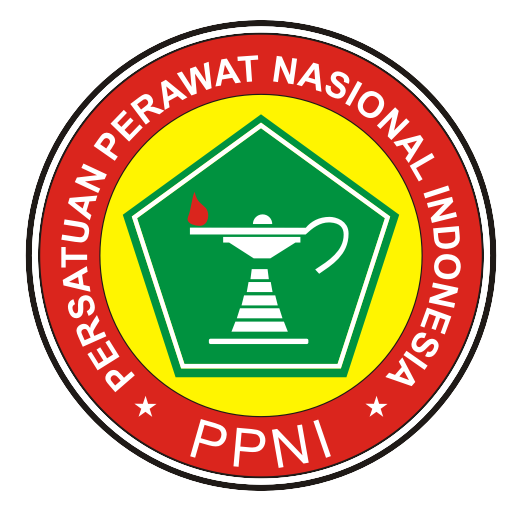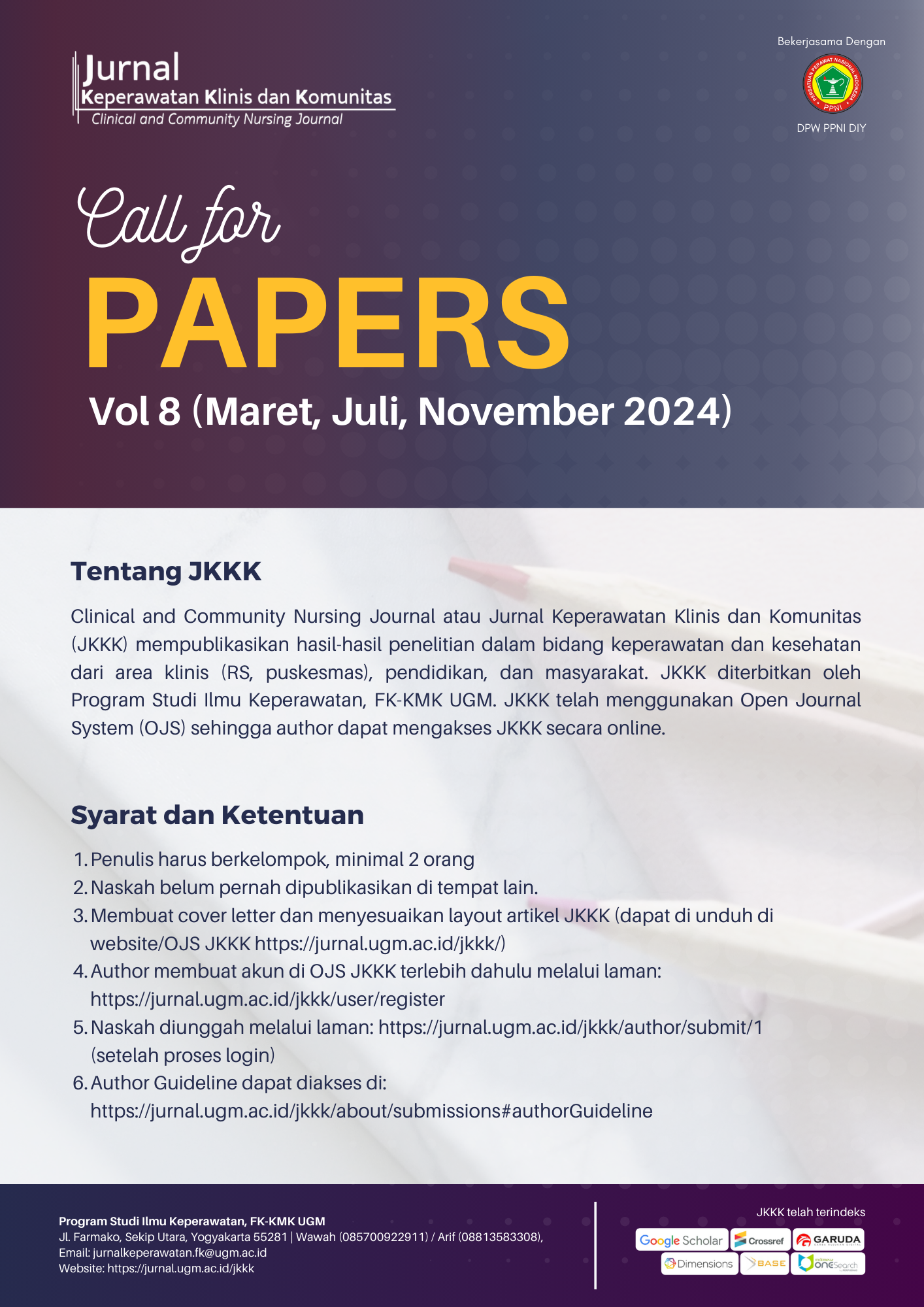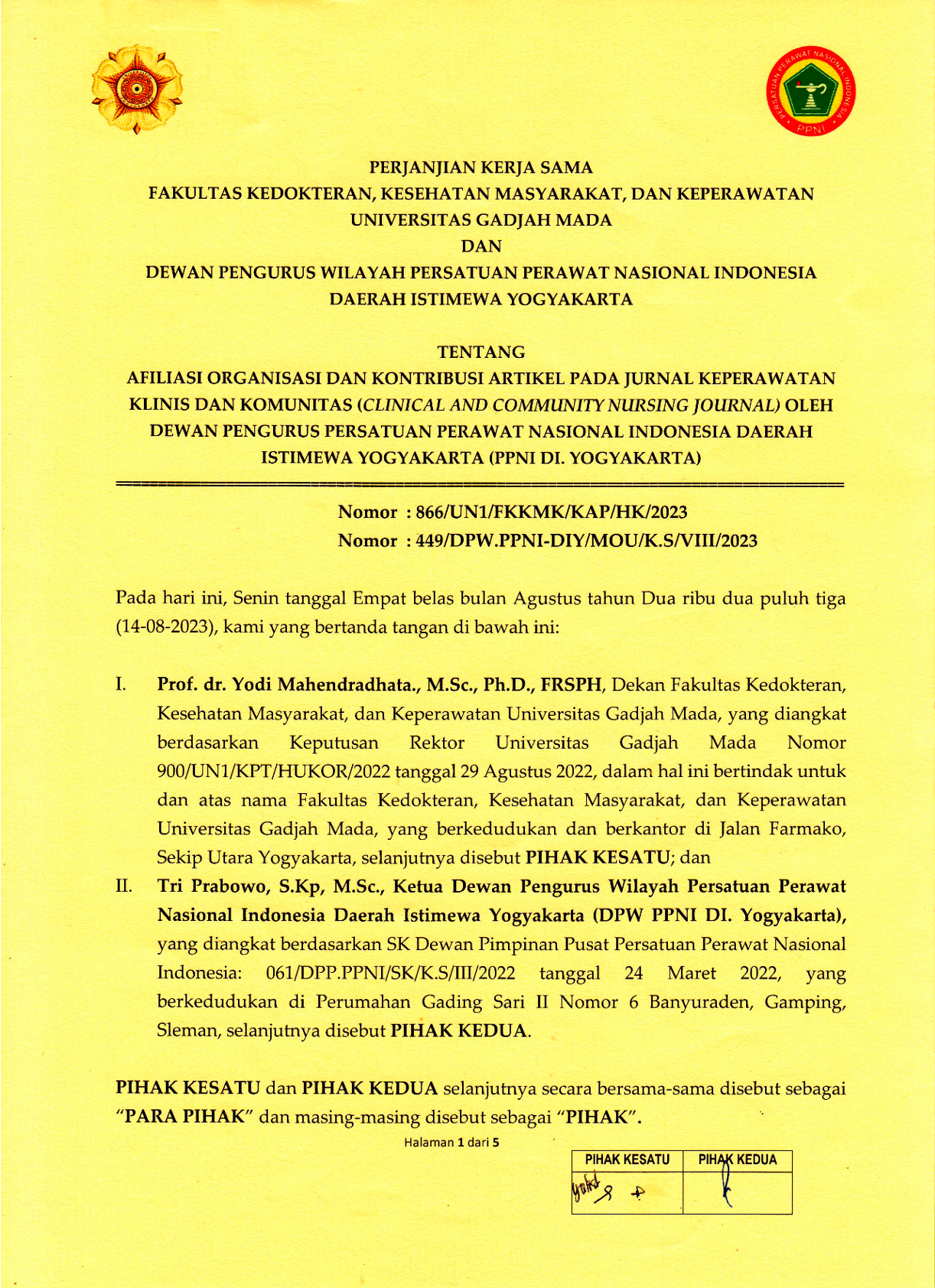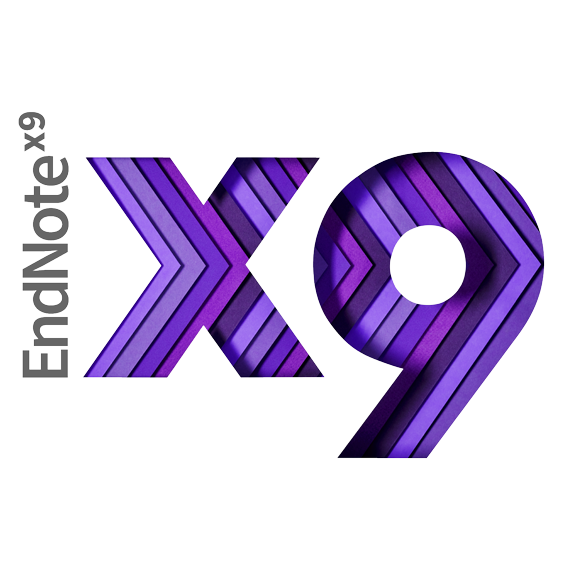Online Submissions
Already have a Username/Password for Jurnal Keperawatan Klinis dan Komunitas (Clinical and Community Nursing Journal)?
Go to Login
Need a Username/Password?
Go to Registration
Registration and login are required to submit items online and to check the status of current submissions.
Author Guidelines
GENERAL GUIDANCE FOR RESEARCH ARTICLES WRITING
Jurnal Keperawatan Klinis dan Komunitas (Clinical and Community Nursing Journal) calls for research articles, literature reviews, case studies, and psychometric testing. The following are the general rules or guidelines for the writing format and submission requirements.
- The manuscript is suggested to be at least 3-5 years old from research conducted and have never been published elsewhere.
- The manuscript is in soft copy and typed in Microsoft Word. The file is uploaded to OJS JKKK (https://jurnal.ugm.ac.id/jkkk).
- The author has to make a cover letter and sign a statement that the submitted manuscript is the result of his/her work and has never been published in any other journal and other authors have agreed to publish it in JKKK. Example of cover letter can be seen on the website.
- The author has to create an account at OJS JKKK through the following page: https://jurnal.ugm.ac.id/jkkk/user/register
- After logging in, the author can upload the manuscript via the following page: https://jurnal.ugm.ac.id/jkkk/author/submit/1
RESEARCH ARTICLES WRITING FORMAT
Writing format for title, author's name, and affiliation
- The title is written in Indonesian and English no more than 16 words, with Arial font, size 11, and bold print.
- For special research (case study and literature review), the type of research must be added to the title.
- The name of the author is not followed by a title and affiliation.
- The main author must provide the e-mail address of corresponding author(s) used in the OJS JKKK account.
Abstract writing
- The abstract is written using proper Indonesian and English.
- The abstract in English is expected to have gone through the translation and editing process to assure the quality of the language used.
- The abstract is written no more than 250 words.
- The abstract must include 3-5 keywords sorted according to the alphabet and separated by semicolon (;).
- The abstract is written using Arial font, size 10, and 1 space.
Writing and formatting of the manuscript
- The manuscript is written in Indonesian.
- The manuscript is written using Microsoft Word with Arial font size 11, A4 paper size, margin 2.5 cm, and 1.5 spaces.
Presentation of tables
The table is created using 1 space. The lines used in the table are only horizontal lines. The table title is placed on the table with font size 9 written in the middle. The font size of the text is 9. The table is limited to a maximum of 6-7 pieces. Table headings use sequential numbering (1, 2, etc). Table titles include What, When, Where, and How many (samples). Example of table presentation can be seen below.
Decimal numbers are written only with 1 digit after the comma (x,x), and the mean and standard deviation values use 2 digits after the comma (y,yy), while the significance value (p, r, etc.) uses 3 digits. after the comma (z,zzz).
Presentation of graphs
Graphs are not presented using gridlines, shadow, glow, 3D effects, and graph frames. The title of the chart uses a 9-letter size with 1 space.
Presentation of photos/ images
Acceptable photos/images are photos/images with a minimum resolution of 300 dpi with a JPEG (.jpg) or PNG (.png) extension (use image processing software to check the dpi).
Reference writing format
The reference is written based on the Vancouver superscript reference writing format, font size 10 with 1 space between lines. References are listed in numerical order, and in the same order as they are cited in the manuscript. The reference contains only references that are cited in the manuscript. Identify references with Arabic numerals (1, 2, 3, 4, 5, 6, 7, 8, 9) as superscript . Check the details of the reference based on the actual source. It is recommended to use software to write references such as Mendeley, End Note, or Zotero (can be downloaded at OJS). The author is responsible for the accuracy and completeness of the references. Be consistent with the reference style throughout the manuscript.
Examples of citation and reference writing format can be seen below.
For citation writing that includes the original author's name, the reference identification number is written after the author's name.
Example: According to Wulandari,5 problems that may be faced by students include the difficulty of formulating themes, titles, samples, measuring tools, obtaining references, the limited time, the repeated revision process, difficult to meet with supervisors, feedback from supervisors, and so on.
Anther method of writing citations is that the reference identification number is written after the end of the sentence after the dot (.) or comma (,) which contains sentences/citations from the edited article without including the author's name.
Example: Problems that may be faced by students include the difficulty of formulating themes, titles, samples, measuring tools4, obtaining references, the limited time, the repeated revision process, difficult to meet with supervisors, feedback from supervisors, and so on.5
For writing citations from two or more sources that are not sequential, the identification numbers are separated by commas (,).
Example: Problems that may be faced by students include the difficulty of formulating themes, titles, samples, measuring tools4,7,9, obtaining references, the limited time, the repeated revision process, difficult to meet with supervisors, feedback from supervisors, and so on.5
For writing citations from more than two consecutive sources, the writing is in the form of a range linked to a strip sign (-).
Example: Problems that may be faced by students include the difficulty of formulating themes, titles, samples, measuring tools, obtaining references, the limited time, the repeated revision process, difficult to meet with supervisors, feedback from supervisors, and so on.4-7
Example of reference writing format:
Author of Chapter Book:
Feldman JN, Tilling RI. Chapter 15: Volcanic Eruptions, Hazards, and Mitigation. Volcano Hazards. Wilderness Medicine. 6 ed. Philadelphia: Mosby Elsevier; 2011.
Author of Individual Book:
Nunnaly, J.C., Bernstein, I.H. Psychometric theory. New York: McGraw-Hill.
Editor as author:
Schofield M. editor. Sampling in Quantitative Research. 2 ed. French Forest, New South Wales: Pearson education; 2003.
Articles in the Journal:
Joventino ES, Ximenes LB, da Penha JC, Andrade LC, de O, de Almeida PC. The Use of Educational Video to Promote Maternal Self-Efficacy in Preventing Early Childhood Diarrhea. Int J Nurs Pract. 2017; 23 (3):1-7. DOI: 10.1111/ijn.12524.
Undergraduate thesis or dissertation:
Wardhani MA. Overview of Self-Efficacy Levels for Breastfeeding in Primigravida Mothers [Thesis]. Jakarta: Faculty of Nursing Sciences, Universitas Indonesia; 2012.
World wide web (WWW):
Department of Health. Lupus Erimatrosus: Guidance for healthcare workers [homepage on the internet]. c2003. [updated 23 Mar 2003; cited 9 Nov 2003]. Available from: http://www.doh.gov.uk/pdfs
Paper in conference/seminar Proceedings:
Warsini S, Kanbara S, Alim S. The Health Problems Among Jogjakarta's Survivors After Java Earthquake. Presented at IWSDN 2010. Proceedings of The First Research Conference of the World Society of Nursing Disaster; 2010 Jan 9-10; Kobe, Japan.
Poster in conference:
Chasman J, Kaplan RF. The effects of occupation on preserved cognitive functioning in dementia. Poster session presented at: Excellence in clinical practice, 4th Annual Conference of the American Academy of Clinical Neuropsychology; 2006 Jun 15-17; Philadelphia, PA.
STRUCTURE OF ARTICLE
RESEARCH ARTICLE/PSYCHOMETRIC TESTING ARTICLE
1. ABSTRACT (ABSTRAK)
Abstract written in 2 (two) languages English and Indonesian. The maximum number of words is 250 words.
- Background (Latar belakang): shows the interests or needs of the research.
- Objective (Tujuan)
- Method (Metode): contains the type and design of the study, the number of samples and sampling techniques, instruments, and analysis used.
- Results (Hasil): contains the main results (which answer the objectives of the study).
- Conclusion (Simpulan)
- Keywords include 3-5 words.
*) For more details, see the RESEARCH ARTICLES WRITING FORMAT section and journal templates.
2. INTRODUCTION (PENDAHALUAN)
Introduction contains the background of the importance of this research, the formulation of the problem and the objective of the research.
3. RESEARCH METHOD (METODE PENELITIAN)
This section contains the type and design of the study, the time and place of the study, the population, the sample (large sample, sampling technique, inclusion and exclusion criteria), the research instrument (description of the instrument, validity and reliability, and interpretation of the instrument), and the data analysis technique. Writing techniques do not need to have specific subheadings for populations, samples, instruments, and others.
Word abbreviations should be explained at the beginning and used consistently until the end of the manuscript. If the method used comes from a previous publication, please list the references used and explain if there are modifications.
Write down the ethical feasibility obtained for the research conducted and informed consent.
4. RESULTS (HASIL)
The authors are expected to include data relevant to the focus of the study. The results can be presented in the form of tables or graphs. The results should be presented appropriately along with explanations without reference to the literature.
The author has to report the original and important findings. Discussion, speculation, and interpretation of data in detail are not included in the results, but in the discussion section. The writing technique does not need to have a specific subheading for each variable.
Presentation of tables, charts, and figures
*) For more details, see the RESEARCH ARTICLES WRITING FORMAT section and journal templates.
5. DISCUSSION (PEMBAHASAN)
Discussion should include the main results of the discussion and be elaborated by additional outcomes that are interesting to discuss. The discussion should emphasize the results of the latest findings. The discussion is corroborated with references to previous studies. The author should write down the relationship between the results with the context of the target population and the possibility of generalization to other populations.
6. CONCLUSION AND SUGGESTIONS (SIMPULAN DAN SARAN)
This section contains answers from the research objectives along with suggestions that are in accordance with the main results of the study. The conclusions are written in the form of paragraphs and not in the form of points.
7. ACKNOWLEDGMENT (UCAPAN TERIMA KASIH)
Acknowledgment is written separately at the end of the article before the reference and not on the title page, not as a footnote to the title or otherwise. Acknowledgment goes to the party who provided assistance during the research. Conflict of interest must be written clearly (if any). Conflict of interest is a financial, commercial, legal or professional relationship between researchers and companies or sponsors that can affect the results of research. Include the source of funding (example a research grant from a university or college). Write in the form of paragraphs and not in the form of points.
8. REFERENCES (DAFTAR PUSTAKA)
*) For more details, see the RESEARCH ARTICLES WRITING FORMAT section and journal templates.
CASE STUDY
1. ABSTRACT (ABSTRAK)
Abstract written in 2 (two) languages English and Indonesian. The word count is 150 words. It discusses the importance of conducting the case study and its benefits.
- Background (Latar belakang): contains the uniqueness and novelty of the case.
- Objective (Tujuan)
- Case report (Case report): contains symptoms, nursing care plan (if case study is nursing care) or therapeutic intervention (if case study is an intervention)
- Results (Hasil)
- Conclusion (Simpulan)
- Keywords (Kata kunci): include 3-5 words.
2. INTRODUCTION (PENDAHULUAN)
The introduction of case study contains the background, the importance of this research, the uniqueness of the case, and the objectives of the case study.
3. RESEARCH METHODS (METODE PENELITIAN)
Patient-related information discusses the information from the patient including sociodemographic data, the main complaints and symptoms experienced, the history of the disease, and the family and psychosocial condition. The name of the patient is written anonymously.
Clinical manifestations/findings describes the significant physical examination and important clinical findings.
History of the disease discusses updated information and treatment history.
Etiology, disease risk factors, and pathophysiology presents a comparison of etiology and risk factors based on existing theories and based on those suffered by patients.
Diagnostic testing presents lab examinations, X-rays, surveys, medical diagnosis (including other diagnoses), and prognosis.
If the type of case study is nursing care, the manuscript should include nursing assessment, nursing care plan (NANDA, NOC, NIC & SDKI, SLKI, SIKI, SOAP) from Askep.
If the type of case study is a therapeutic intervention, the manuscript should
- describe the type of therapeutic intervention (pharmacological, surgical, preventive, and self-care);
- explain administration of therapeutic interventions (dose and duration);
- report interventions in detail and in order of time;
- explain the results of the given intervention; and
- explain the side effects and unanticipated events.
4. RESULTS (HASIL)
Author is expected to include data relevant to the focus of the case study. Results can be presented in the form of tables or graphs.
Results should be presented appropriately along with explanations without reference to the literature. The author should report the original and important findings. Discussion and interpretation of data in detail are not included in the results, but in the discussion section. The writing technique does not need to have a specific subheading for each variable.
Presentation of tables, charts, and figures
*) For more details, see the RESEARCH ARTICLES WRITING FORMAT section and journal templates.
5. DISCUSSION (PEMBAHASAN)
The discussion should focus on the discussion about nursing care or interventions carried out, nursing theory used in the case study, main lesson learnt that can be taken from the case study, and the patient's perspective on the medical actions and care received.
6. CONCLUSION AND SUGGESTIONS (SIMPULAN DAN SARAN)
See guidance section research article/psychometric testing article.
7. ACKNOWLEDGMENT (UCAPAN TERIMA KASIH)
See guidance section research article/psychometric testing article.
8. REFERENCES (DAFTAR PUSTAKA)
*) For more details, see the RESEARCH ARTICLES WRITING FORMAT section and journal templates.
LITERATURE REVIEW
1. ABSTRACT (ABSTRAK)
Abstract written in 2 (two) languages English and Indonesian. The word count is 150 words.
- Background (Latar belakang): shows the importance or need of conducting a literature review and its benefits.
- Objective (Tujuan)
- Method (Metode): explains the database and the keywords used, the inclusion and exclusion criteria used, the article selection process, critical appraisal, and the result synthesis process.
- Results (Hasil)
- Conclusion (Simpulan)
- Keywords (Kata kunci): include 3-5 words.
*) For more details, see the RESEARCH ARTICLES WRITING FORMAT section and journal templates.
2. INTRODUCTION (PENDAHULUAN)
This section discusses the background, the importance of the review, and the objectives of the literature review.
3. RESEARCH METHOD (METODE PENELITIAN)
This section describes the type of review carried out, the database used, the keywords for searching for articles, the inclusion and exclusion criteria for selecting articles, the process of selecting articles, and the critical appraisal process carried out (to assess the quality of the paper accompanied by the critical appraisal form). It should be completed with prism diagram and the analysis discussion.
4. RESULTS (HASIL)
This section presents the article extraction table and synthesis of the review results.
Presentation of tables, charts, and figures
*) For more details, see the RESEARCH ARTICLES WRITING FORMAT section and journal templates.
5. DISCUSSION (PEMBAHASAN)
The results of the review are discussed using the theory and the results of previous research. The discussion should be in accordance with the results.
6. CONCLUSION AND SUGGESTIONS (SIMPULAN DAN SARAN)
See guidance section research article/psychometric testing article.
7. ACKNOWLEDGMENT (UCAPAN TERIMA KASIH)
See guidance section research article/psychometric testing article.
8. REFERENCES (DAFTAR PUSTAKA)
*) For more details, see the RESEARCH ARTICLES WRITING FORMAT section and journal templates.
Submission Preparation Checklist
As part of the submission process, authors are required to check off their submission's compliance with all of the following items, and submissions may be returned to authors that do not adhere to these guidelines.
- My article is in accordance with the style and template of the Jurnal Keperawatan Klinis dan Komunitas (Clinical and Community Nursing Journal).
- Cover Letter that has been filled out and signed by the author's representative (complete with the corresponding author's contact who is still active). Cover letters can be uploaded in the supplementary file(s) or email to jurnalkeperawatan.fk@ugm.ac.ic.
Copyright Notice

Jurnal Keperawatan Klinis dan Komunitas (Clinical and Community Nursing Journal) (p-ISSN: 2614-445, e-ISSN: 2614-498) is licensed under a Creative Commons Attribution-ShareAlike 4.0 International License.
Privacy Statement
The names and email addresses entered in this journal site will be used exclusively for the stated purposes of this journal and will not be made available for any other purpose or to any other party.

Jurnal Keperawatan Klinis dan Komunitas (Clinical and Community Nursing Journal)
collaborates with DPW PPNI DIY
![]()
Jurnal Keperawatan Klinis dan Komunitas (Clinical and Community Nursing Journal) is licensed under a Creative Commons Attribution-ShareAlike 4.0 International License.




